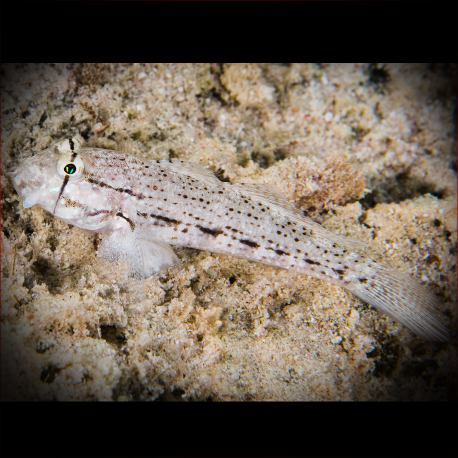More info
Datasheet
| Minimum Tank Size | 150 litres / 39.63 US gallons |
| Maximum Size | 6.0cm / 2.36inches |
| Reef Compatible | Always reef safe |
| Temperament | Mostly peaceful but might be aggressive towards similar species |
| Temperature | 22.2°C / 71.96°F - 25.6°C / 78.08°F |
| Specific Gravity | 1.020-1.025 |
| Carbonate Hardness | 8-12 |
| pH | 8.1-8.4 |
General Description
The Eyebar goby, also known as the Shoulder-spot sandgoby or Cauer eye-bar goby, is a member of the Gobiidae family, specifically Gnatholepis cauerensis, found in the East Indian Ocean, West Indian Ocean, Australia, Japan, the Red Sea, Indonesia, and the Pacific region from South Africa to Pitcairn Island. These small fish are known to live close to the bottom, with their behavior varying greatly, making them intriguing additions to aquarium settings.
Aquarium Suitability
Considered suitable with care, the Eyebar goby demands specific conditions to thrive well in captivity. It is a docile species that is quite shy, necessitating caution when housed with more aggressive tank mates. This goby filters sand for food but is not as proficient at it compared to other sand-dwelling gobies. Regular feeding is crucial, especially when first introduced, and providing quality hiding places, such as live rocks, is essential. These fish tend to do better when kept without other members of the same species in the aquarium.
Care and Hardiness
With an average hardiness level, the Eyebar goby thrives best in a well-maintained tank environment. They require feeding several times a day, especially upon initial introduction to the aquarium, and are known to consume detritus, small crustaceans like krill and mysis, and zooplankton such as cyclops and pods. These fish prefer a tank size of at least 150 liters and need stable water conditions with a pH range of 8.1-8.4, a temperature between 22.2-25.6°C, and a specific gravity of 1.020-1.025.
Reef Suitability
The Eyebar goby is considered always reef-safe, making it a suitable addition to reef aquariums without posing a threat to corals or other invertebrates. Their peaceful temperament is generally conducive to a reef setting, although they may display aggression towards similar species if housed together.
Aquarium Setup
When setting up an aquarium for the Eyebar goby, it is essential to provide hiding spots among live rocks and ensure a sandy substrate for them to sift through. Maintaining stable water parameters within the recommended ranges, along with offering a varied diet to meet their nutritional needs, is crucial for the well-being of these small, interesting fish.
Behaviour
The Eyebar goby is known for its shy and docile nature, often hiding among rocks or in sand beds. They may exhibit territorial behavior if kept with similar species but are generally peaceful towards other tank mates. These gobies are active sand-sifters, constantly searching for food particles in the substrate.
Feeding and Diet
In the aquarium, the Eyebar goby thrives on a diet consisting of detritus, small crustaceans like krill and mysis, as well as zooplankton such as cyclops and pods. Frequent feeding, especially during the acclimatization period, is essential to ensure their overall health and vitality.
Dimorphism
The Eyebar goby does not exhibit significant dimorphism, making it challenging to visually differentiate between male and female individuals easily. In a captive setting, these gobies can reproduce with proper care and suitable tank conditions that mimic their natural habitat.
Habitat and Distribution
Found across the Indo-Pacific region, the Eyebar goby's distribution ranges from South Africa to Pitcairn Island, extending north to Miyake-jima, Japan, and south to Sydney Harbour, Australia. They are also observed in the Indian Ocean from Djibouti to Kwa-Zulu Natal, thriving in a variety of marine environments along sandy bottoms and rocky reefs.

